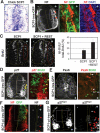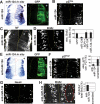The microRNA miR-124 antagonizes the anti-neural REST/SCP1 pathway during embryonic CNS development
- PMID: 17403776
- PMCID: PMC1838526
- DOI: 10.1101/gad.1519107
The microRNA miR-124 antagonizes the anti-neural REST/SCP1 pathway during embryonic CNS development
Abstract
Neuronal gene expression is tightly regulated in developing CNS. Here, we demonstrate the anti-neural function of phosphatase SCP1 (small C-terminal domain phosphatase 1) during development. We further show that the neuron-enriched microRNA miR-124 directly targets SCP1-3' untranslated region (UTR) to suppress SCP1 expression. In developing spinal cord, expression of miR-124 and SCP1 is complementary, and miR-124 antagonism phenocopies SCP1 overexpression and vice versa. In P19 cells, miR-124 suppresses SCP1 expression and induces neurogenesis, and SCP1 counteracts this proneural activity of miR-124. Our results suggest that, during CNS development, timely down-regulation of SCP1 is critical for inducing neurogenesis, and miR-124 contributes to this process at least in part by down-regulating SCP1 expression.
Figures




Similar articles
-
MicroRNA 26b encoded by the intron of small CTD phosphatase (SCP) 1 has an antagonistic effect on its host gene.J Cell Biochem. 2012 Nov;113(11):3455-65. doi: 10.1002/jcb.24222. J Cell Biochem. 2012. PMID: 22678827
-
Phosphatase activity of small C-terminal domain phosphatase 1 (SCP1) controls the stability of the key neuronal regulator RE1-silencing transcription factor (REST).J Biol Chem. 2018 Oct 26;293(43):16851-16861. doi: 10.1074/jbc.RA118.004722. Epub 2018 Sep 14. J Biol Chem. 2018. PMID: 30217818 Free PMC article.
-
Cellular Prion Protein Promotes Neuronal Differentiation of Adipose-Derived Stem Cells by Upregulating miRNA-124.J Mol Neurosci. 2016 May;59(1):48-55. doi: 10.1007/s12031-016-0733-8. Epub 2016 Mar 7. J Mol Neurosci. 2016. PMID: 26947028
-
miR-124-9-9* potentiates Ascl1-induced reprogramming of cultured Müller glia.Glia. 2016 May;64(5):743-62. doi: 10.1002/glia.22958. Epub 2016 Jan 6. Glia. 2016. PMID: 26732729 Free PMC article.
-
The role of the miR-17-92 cluster in neurogenesis and angiogenesis in the central nervous system of adults.J Neurosci Res. 2017 Aug;95(8):1574-1581. doi: 10.1002/jnr.23991. Epub 2016 Nov 21. J Neurosci Res. 2017. PMID: 27869313 Review.
Cited by
-
MiR-124 synergism with ELAVL3 enhances target gene expression to promote neuronal maturity.Proc Natl Acad Sci U S A. 2021 Jun 1;118(22):e2015454118. doi: 10.1073/pnas.2015454118. Proc Natl Acad Sci U S A. 2021. PMID: 34031238 Free PMC article.
-
The genetic and epigenetic journey of embryonic stem cells into mature neural cells.Front Genet. 2012 May 18;3:81. doi: 10.3389/fgene.2012.00081. eCollection 2012. Front Genet. 2012. PMID: 22629283 Free PMC article.
-
Kuwanon V inhibits proliferation, promotes cell survival and increases neurogenesis of neural stem cells.PLoS One. 2015 Feb 23;10(2):e0118188. doi: 10.1371/journal.pone.0118188. eCollection 2015. PLoS One. 2015. PMID: 25706719 Free PMC article.
-
Electroporation of cDNA/Morpholinos to targeted areas of embryonic CNS in Xenopus.BMC Dev Biol. 2007 Sep 27;7:107. doi: 10.1186/1471-213X-7-107. BMC Dev Biol. 2007. PMID: 17900342 Free PMC article.
-
Regulation of MicroRNA Biogenesis: A miRiad of mechanisms.Cell Commun Signal. 2009 Aug 10;7:18. doi: 10.1186/1478-811X-7-18. Cell Commun Signal. 2009. PMID: 19664273 Free PMC article.
References
-
- Alvarez-Garcia I., Miska E.A., Miska E.A. MicroRNA functions in animal development and human disease. Development. 2005;132:4653–4662. - PubMed
-
- Ambros V. The functions of animal microRNAs. Nature. 2004;431:350–355. - PubMed
-
- Andres M.E., Burger C., Peral-Rubio M.J., Battaglioli E., Anderson M.E., Grimes J., Dallman J., Ballas N., Mandel G., Burger C., Peral-Rubio M.J., Battaglioli E., Anderson M.E., Grimes J., Dallman J., Ballas N., Mandel G., Peral-Rubio M.J., Battaglioli E., Anderson M.E., Grimes J., Dallman J., Ballas N., Mandel G., Battaglioli E., Anderson M.E., Grimes J., Dallman J., Ballas N., Mandel G., Anderson M.E., Grimes J., Dallman J., Ballas N., Mandel G., Grimes J., Dallman J., Ballas N., Mandel G., Dallman J., Ballas N., Mandel G., Ballas N., Mandel G., Mandel G. CoREST: A functional corepressor required for regulation of neural-specific gene expression. Proc. Natl. Acad. Sci. 1999;96:9873–9878. - PMC - PubMed
-
- Ballas N., Battaglioli E., Atouf F., Andres M.E., Chenoweth J., Anderson M.E., Burger C., Moniwa M., Davie J.R., Bowers W.J., Battaglioli E., Atouf F., Andres M.E., Chenoweth J., Anderson M.E., Burger C., Moniwa M., Davie J.R., Bowers W.J., Atouf F., Andres M.E., Chenoweth J., Anderson M.E., Burger C., Moniwa M., Davie J.R., Bowers W.J., Andres M.E., Chenoweth J., Anderson M.E., Burger C., Moniwa M., Davie J.R., Bowers W.J., Chenoweth J., Anderson M.E., Burger C., Moniwa M., Davie J.R., Bowers W.J., Anderson M.E., Burger C., Moniwa M., Davie J.R., Bowers W.J., Burger C., Moniwa M., Davie J.R., Bowers W.J., Moniwa M., Davie J.R., Bowers W.J., Davie J.R., Bowers W.J., Bowers W.J., et al. Regulation of neuronal traits by a novel transcriptional complex. Neuron. 2001;31:353–365. - PubMed
-
- Ballas N., Grunseich C., Lu D.D., Speh J.C., Mandel G., Grunseich C., Lu D.D., Speh J.C., Mandel G., Lu D.D., Speh J.C., Mandel G., Speh J.C., Mandel G., Mandel G. REST and its corepressors mediate plasticity of neuronal gene chromatin throughout neurogenesis. Cell. 2005;121:645–657. - PubMed
Publication types
MeSH terms
Substances
Grants and funding
LinkOut - more resources
Full Text Sources
Other Literature Sources
Molecular Biology Databases
